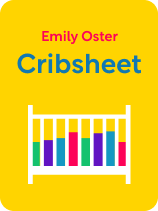

This article is an excerpt from the Shortform book guide to "Cribsheet" by Emily Oster. Shortform has the world's best summaries and analyses of books you should be reading.
Like this article? Sign up for a free trial here.
How do you make data-driven decisions as a parent? What is actionable data? How do you apply data to your situation?
Health economist Emily Oster claims that decisions around parenting are often overwhelming because you must navigate moral judgments, contradictory advice, and confusing data. In Cribsheet, she explains how to make data-driven decisions in parenting by gathering actionable data.
Read on for Oster’s guide to making data-driven parenting decisions, including each step involved.
Making Data-Driven Parenting Decisions
According to Cribsheet author Emily Oster, the first step in making data-driven decisions as a parent is basing your decisions on actionable data: data that reveal which actions cause which outcomes. Here, we’ll explore why data from randomized trials are more actionable, and therefore more useful, than data from observational studies.
The Most Actionable Type of Study: Randomized Trials
Oster argues that you should base your parenting decisions on data from randomized trials because these studies’ data reveal causality. Randomized trials are a type of experiment in which researchers first randomly sort test subjects into groups. Then, they select one of those groups to experience the variable under study. This process ensures that there are no differences between the groups other than that variable. Therefore, researchers can conclude that any difference in the groups’ outcomes results from the variable studied. This reveals causality. As previously noted, studies that demonstrate causality are more actionable.
(Shortform note: Even research that does show causality may not necessarily be actionable for every family. The identities of research participants don’t always mirror the identities of parents who consult that research. For example, transgender parents are underrepresented in research on parenting, and research on cisgender parents may not necessarily feel actionable to them: A randomized trial on cisgender parents’ milk supply likely won’t include data on how testosterone hormone therapy impacts milk production. In cases like these, transgender parents can still seek information by asking their doctor for help applying studies’ results to their situation or by joining a community support group.)
A Less Actionable Type of Study: Observational Studies
According to Oster, when making a data-driven decision, you should limit how much you base your parenting decisions on data from observational studies because they don’t reveal causality. These types of studies, which make up the majority of research on parenting decisions, compare groups of people without experimenting on them. Observational studies reveal correlations: evidence that two variables are related. Because they don’t involve an experiment, researchers can’t conclude whether outcomes result from parents’ actions or from other differences in their lives. Therefore, these studies don’t provide evidence of causality. This makes them less actionable.
(Shortform note: What if the only data available on the topic you’re researching are from observational studies? In this situation, it’s still better to rely on observational data over anecdotes. When someone you know or someone online shares information about their parenting decision, it’s an anecdote. Observational studies are more likely to provide a balanced viewpoint compared to anecdotal evidence: Whereas information from anecdotes tends to represent only one individual’s perspective, observational studies tend to reflect the outcomes for multiple participants or the average of the outcomes those participants experienced.)
Consider Your Unique Situation
The data you gather from randomized trials should inform your decision, but they shouldn’t determine your decision. According to Oster, in addition to data-driven decision making, you should also consider your and your family’s unique situation: what’s best for your baby, you, and your budget. Results from randomized trials reveal what’s best for the participants in the trial, who may have had different needs, desires, and circumstances than your family.
(Shortform note: To ensure you consider what’s best for your family, you may need to make your decision away from others’ influence. In Predictably Irrational, Dan Ariely claims that when you make a decision in the presence of others, you may feel pressured to make a choice that isn’t in your best interest. This is because it’s human nature to want to maintain others’ image of you. By contrast, when you make a decision privately, you’re more likely to choose what you actually want or need.)
When considering what’s best for you, Oster emphasizes that what’s good for you is often good for your child, too. Therefore, it’s important to consider your own desires, needs, and lifestyle when making a parenting decision. Oster claims that, unfortunately, many parents often choose what they believe is best for their child even when this choice would negatively impact them. Deprioritizing their own needs negatively impacts their mental or physical health, which harms them and their children.
(Shortform note: Research supports Oster’s claim that parents sometimes prioritize their children’s needs over their own. For example, many parents are too busy working and spending time with their children to invest in developing their own friendships. Furthermore, some economists argue that economic inequality has led parents to prioritize preparing their children for their future over attending to their own needs as parents.)
Below, we share a series of steps to take when you’ve examined the research on a topic and you’re ready to make an informed decision.
Step 1: List the Risks and Benefits
First, list each option’s risks and benefits for your child, you, and your budget. In addition to using data-driven decision making to gather information, brainstorm your own risks and benefits. For instance, one risk of adopting a furry pet is that your baby is more likely to get bit and develop an infection. On the other hand, adopting a furry pet has benefits: It’ll bring you and your child joy.
(Shortform note: As you consider an option’s risks and benefits for your family, you may also want to also consider how an option affects your community. Some parents make decisions that they believe are best for their children and family, but they fail to consider how their decisions could contribute to social inequality. For instance, some white families perpetuate racial segregation when they choose to send their children to schools that enroll a higher proportion of white students.)
Step 2: Conduct a Risk Assessment
Second, consider how the risks you listed compare to the risks you regularly, automatically take. For example, research reveals that 10 to 20 people (predominantly children) die from animal bites every year in the US, but close to 1,000 US children die each year in car crashes. This comparison reveals that your child’s risk of death from an animal bite is significantly low relative to the risk of having them ride in a car. Next, ask yourself: Are there any ways I could minimize this risk? For instance, you could closely supervise your child and pet any time they’re together.
(Shortform note: When using a data-driven approach to conduct a risk assessment, resist the temptation to believe you and your family are an exception to the statistics you encounter. In Nudge, Richard Thaler and Cass Sunstein argue that people tend to possess an optimism bias that convinces them they’re less likely to suffer negative outcomes than other people.)
Step 3: Consider Opportunity Costs
Finally, for each option you’re considering, ask yourself: If I pursued this option, what benefits or opportunities would my family miss out on? For instance, if you don’t get a pet, you’ll never have to find a pet sitter. This might make it possible for your family to travel more often.
(Shortform note: As previously noted, considering opportunity costs can be overwhelming, and after you’ve made a decision, you may look back on the opportunity costs you considered and regret your choice. In The Paradox of Choice, Barry Schwartz claims you can avoid these scenarios by being a satisficer, not a maximizer. Satisficers spend less time on decisions because they’re satisfied with an option that’s good even if it’s not perfect. By contrast, maximizers take time to deeply consider every possibility until they find the best one. They’re more likely than satisficers to regret their decisions.)

———End of Preview———
Like what you just read? Read the rest of the world's best book summary and analysis of Emily Oster's "Cribsheet" at Shortform.
Here's what you'll find in our full Cribsheet summary:
- Why there isn't one right way to parent a young child
- How to make research-based parenting decisions
- When you should start potty training your toddler






